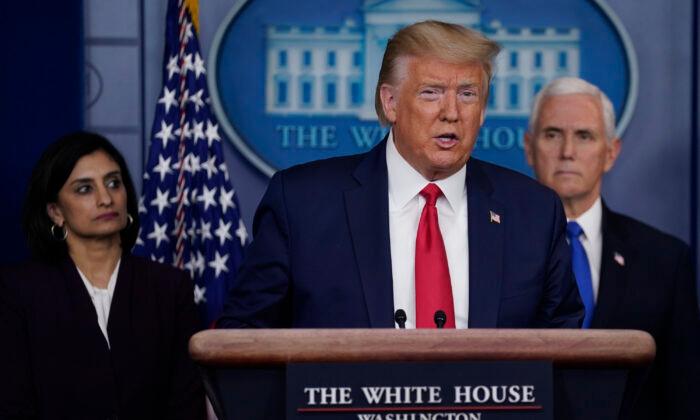“That’s always the toughest enemy, the invisible enemy, but we’re going to defeat the invisible enemy,” Trump said at the March 18 briefing. “I think we’re going to do it even faster than we thought.”
The DPA allows the president to direct the production of private sector firms of critical manufactured goods to meet urgent national security needs.
Trump’s move seeks to marshal additional resources for America’s emergency response to the CCP virus, commonly known as the novel coronavirus. The Epoch Times refers to the novel coronavirus as the CCP virus because the Chinese Communist Party’s coverup and mismanagement allowed the virus to spread throughout China and create a global pandemic.
Trump said he would sign the DPA measure on March 18, adding that it was being deployed “just in case” and that it “could do a lot of good things, if we need it.”

‘We Must Mobilize’
Earlier, more than two dozen senators urged Trump to invoke the Korean War-era program to increase production of masks, ventilators, and respirators, as well as expand hospital capacity to combat the outbreak.“It’s used in times of war, but we must mobilize as if it is a time of war when it comes to hospitals, beds, supplies, equipment.”

‘Leaning Forward’
Defense Secretary Mark Esper said at the March 18 briefing that the military is “leaning forward” in its response against the virus.Esper said the military would provide more than 5 million respirators from its own strategic reserves and supply them to the HHS. He added that 1 million masks would be “available immediately.”
The Pentagon said on March 17 that it would also provide 2,000 specialized ventilators to federal health authorities.
Esper also said that on March 17, he received a briefing at the U.S. Army Medical Research Institute of Infectious Diseases at Fort Detrick, Maryland, which he called “probably the military’s premier research institute.”
The secretary said the Fort Detrick facility is part of an interagency team working on a COVID-19 vaccine and therapeutics.
“They’re making great progress there,” he said, adding that the Pentagon would certify its 16th lab to help process COVID-19 tests from across the country.
He said a number of field and expeditionary hospitals were ordered to prepare for deployment if needed.
Esper also said he would meet with New York state authorities to determine how the military could potentially assist in their efforts to contain the virus.
De Blasio said on March 18 that he’s “almost to the point” of recommending to New York Gov. Andrew Cuomo that the city implement a “shelter-in-place” policy that would have people stay in their homes.
In a massive federal effort on March 17, Trump asked Congress to speed emergency checks to Americans, enlisted the military for MASH-like hospitals, and implored ordinary people—particularly socially active millennials—to do their part by staying home to stop the spread of the virus.
Trump’s proposed economic package alone could approach $1 trillion, a rescue initiative not seen since the Great Recession.
“It’s going to be big, it’s going to be bold, and the level of enthusiasm to get something done—I don’t think I’ve ever seen anything quite like it,” Trump said of the measure at a March 17 briefing.
Trump wants checks sent to the public within two weeks and is urging Congress to pass the eye-popping stimulus package in a matter of days.





